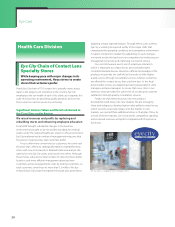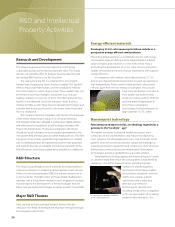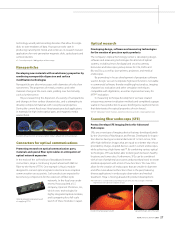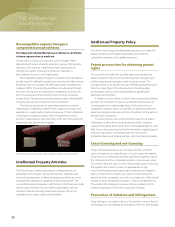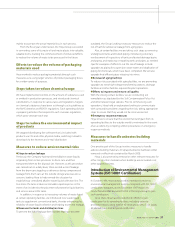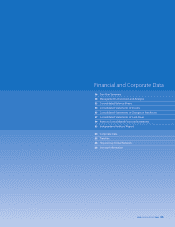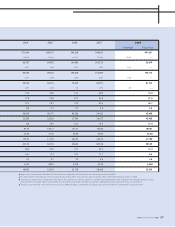Pentax 2008 Annual Report Download - page 30
Download and view the complete annual report
Please find page 30 of the 2008 Pentax annual report below. You can navigate through the pages in the report by either clicking on the pages listed below, or by using the keyword search tool below to find specific information within the annual report.
R&D and Intellectual
Property Activities
Developing biocompatible bone prostheses to contribute
to bone regeneration in medicine
Human bone consists of a nanostructure of collagen fibers
deposited with arrays of apatite particles (a group of phosphate
minerals). This structure is believed to form spontaneously
through the surface interactions of the two materials, a
phenomenon known as self-organization.
Biocompatible organic/inorganic composite bone prostheses
are the result of artificially recreating an environment that imitates
bodily functions to catalyze the self-organization of apatite and
collagen. Within the body, the prostheses are absorbed through
the same mechanism as normal bone metabolism to form new
bone tissue because they have the same structure as natural
human bone. The prostheses demonstrate excellent functionality,
including sponge-like resilience in moist conditions.
These bone prostheses are garnering attention as a bone
regeneration “scaffolding material” that is approaching practical
application in regenerative medicine because of their substantial
contribution to patients’ quality of life. The prostheses show
promise in applications that unite them with stem cells and bone
morphogenetic protein technologies.
The Hoya Group’s intellectual property strategy protects its
proprietary technologies. Along with business strategies and
technical development, intellectual property activities are a key
management strategy for supporting continued growth. The
successful business integration with Pentax in the fiscal year under
review augmented the Group’s intellectual property, and we
intend to meld the existing intellectual property of the two
corporations to create unprecedented value.
One of the Hoya Group’s fundamental objectives is to make the
fullest possible use of intellectual property to bolster the
competitive strengths of its global businesses.
To ensure the most efficient possible patent prosecution for
obtaining patent rights, technical development managers and
intellectual property managers work closely as a team. The
Company aims to secure all necessary intellectual property rights
from the initial stage of the development of leading-edge
technologies, with an eye toward peripheral, applied and
alternative technologies.
In relation to those fields in which Hoya commands a leading
position, the Company focuses on accelerating the process of
securing patents in cutting-edge areas. At the same time, in
competitive markets, Hoya concentrates on promoting efficient
patent prosecution while preventing infringement of the patents
held by other companies.
To achieve these ends, careful technical searches of patent
information at other firms are performed, and the Company
supports the patent prosecution that is most appropriate for each
field. Hoya is also devoting itself to the formation of global patent
networks that will be coordinated with the moves of its
production bases and trading partners into international markets.
Hoya’s individual businesses are not large, but the Company
strives to improve its competitiveness in each respective market.
Hoya focuses on effectively and fully utilizing the patents that are
the cornerstone of the competitive position its businesses enjoy.
This means there are cases in which Hoya might assign licenses to
third parties: for instance, where it is appropriate to sign
cross-licensing agreements granting mutual exercise of patent
rights, or where the Company can expect out-licensing of its
patents to other companies to result in an expansion of the overall
market, or when dictated by changes in Hoya’s competitiveness.
This enables the Company to pursue effective utilization of its
intellectual property in line with its business strategy.
Hoya maintains a constant watch on the market to ensure that its
technologies are not imitated by third parties. When its technologies
Cross-licensing and out-licensing
Prevention of imitation and infringement
Biocompatible organic/inorganic
composite bone prostheses
Intellectual Property Activities
Intellectual Property Policy
Patent prosecution for obtaining patent
rights
The resilience of biocompatible organic/inorganic composite bone prostheses
28




